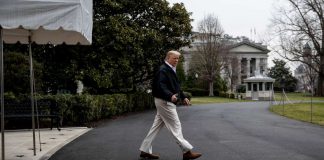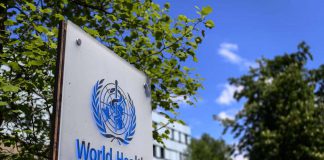APRIL 18, 2020
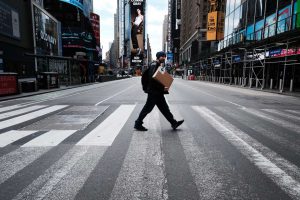
Image: Coronavirus Pandemic Causes Climate Of Anxiety And Changing Routines In America. – Spencer Platt
After flattening the curve, Americans should expect a number of curveballs.
Once the immediate crush of COVID-19 cases subsides, epidemiologists say a “post-peak” purgatory lies ahead until a vaccine can be discovered and disseminated that would allow a return to normalcy.
“When this lockdown ends, it’s not going to be like one day you’re in your house and the next day you’re taking the metro to the ballgame,” said Dr. Robert Murphy, the director of the Institute for Global Health at Northwestern University Feinberg School of Medicine.
“It’s not going to happen like that. It’s going to be gradual.
“You can think of a million different scenarios, and the reason why you have to think of a million scenarios is because nobody is in charge.
“There is no master plan.”
Given the uneven response at the state level — dozens of states have issued stay-at-home orders, starting with California on March 19; governors of eight states have not issued stay-at-home orders — the apexes of the coronavirus cases will hit different states at different times. That makes any uniform national timetable impossible.
Even a gradual easing of restrictions isn’t possible without major increases and improvements in testing, experts say. By mid-April, only about 3 million Americans have been tested for the coronavirus — that’s roughly 1 percent of the U.S. population. Once the outbreak is better contained and the crush on hospitals is alleviated, widespread testing will be the key to catching new clusters as quickly as possible to prevent large-scale community spread.
“There’s a need for expansive testing, both testing people who are symptomatic and their close contacts, as well as testing for the presence of antibodies to see who could be immune,” Jessica Balkus, an assistant professor of epidemiology at the University of Washington, said.
“The single biggest contributor towards how fast we can move towards opening up and easing social distancing is a rapid scale-up in all states and in all areas of testing.”
Assuming that the testing gap will be closed in the coming months, this is how experts foresee how the post-peak life could evolve:
RESTAURANTS/BARS
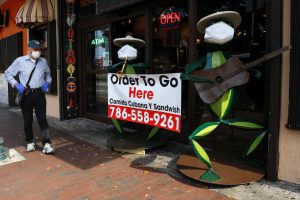
Image: A man wearing a protective mask and gloves walks in front a restaurant offering take-out orders in Miami. – Marco Bello
Quarantined Americans may want to hit their favorite bars as stay-at-home mandates are lifted, but don’t pop open the champagne just yet.
Even if bars and restaurants are allowed to reopen, the likelihood is that it will only be allowed with strict capacity limits.
“There are some hard questions to think about before you can reopen those restaurants and bars,” Balkus said. “You could account for individual patrons with proper social distancing, but it’s also about the safety of the staff. How do you pass people? How do you take orders and deliver food? It would be very hard to maintain 6 feet distance at all times.”
Which may make it difficult for many of those establishments to keep the doors open. “You’re going to see that the mortality rates of bars and restaurants is going to be very high coming out of this,” said Peter Pernicone, the owner of a 190-seat bar, The Elgin, in midtown Manhattan.
“The whole atmosphere of a bar relies on it being full and lively — you need to fill most of those seats in order to make any money,” said Pernicone, who added that the federal stimulus bill is not providing enough to cover more than a little bit of payroll and rent. “If we can fill only 50 percent of the bar, it’s going to be very difficult to survive.”
TRAVEL/HOTEL INDUSTRIES
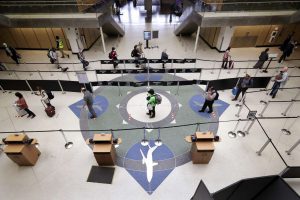
Image: Passengers at Seattle-Tacoma International Airport. – Elaine Thompson
The travel and hotel industries will be slow to bounce back because these industries thrive on crowds of people coming together from various places.
“There will be actions taken by the airlines and the hotel companies to keep things under control in terms of crowds,” Harold Vogel, author of “Entertainment Industry Economics,” said. “Maybe they leave middle spaces open, maybe they reduce the number of people on each flight. They can move some people up to different locations, bought or purchased, some coach seats to premium economy (for social distancing purposes).”
The fear: asymptomatic carriers could come from a part of the country where the disease is not contained and start a new flare-up somewhere else.
“The biggest challenge with the travel question domestically is the fact that we have not had a national coordinated response to staying home,” Balkus said. “There are massive concerns about population mobility.”
Vogel added that it will take much longer for the cruise industry to get back to smooth sailing ahead — both because of the negative associations with the outbreaks on several ships during the early days of the coronavirus crisis and because recreational trips are less essential.
“With a high volume of folks in lots of shared spaces and confined, traveling from port to port — and potentially impacting the communities that are visited — for everyone’s sake, it would probably be best to wait on that one,” she said.
RETAIL

Image: Daily Life In New York City Amid Coronavirus Outbreak, – Cindy Ord
The nation’s $3.9 trillion retail industry has been hit particularly hard, with many brick-and-mortar stores closed, and not all of them destined to reopen. Despite the boon for online shopping, 85 percent of the country’s retail comes through those stores.
Experts say at least some stores will be able to reopen relatively soon — if the number of customers who are allowed inside is limited to allow for social distancing.
“We’re not going to see one light switch come on and the economy comes on,” said Jack Kleinhenz, chief economist for the National Retail Federation, the industry’s biggest trade organization. “We’re going to see a potential of uneasiness as people have insecurity about their jobs and how quickly we recover is going to depend a lot on consumer psychology in many ways.”
JOBS
More than 21 million jobless claims have been filed nationwide in recent weeks as stores and restaurants have shuttered and companies have shed their staff, hiking the unemployment rate to an estimated 15 percent.
Many of those lost jobs may take a long time to return, but there will be plenty of hiring in the coming months. “Obviously, the job sectors that will improve are grocery stores, pharmacies, distribution and warehousing and transportation because so many people are using them or shifting to online shopping,” Kimberly Amadeo, U.S. economic analyst for The Balance, said.
“So, somebody who was a hairdresser may have to ask him or herself, ‘can I get behind driving a truck?'”
Employees can get used to staying at home, Amadeo said, as companies may continue to allow working remotely as a way to keep their offices less crowded for social distancing purposes. There could also be a long range financial incentive to that kind of staffing, with lower rent costs for smaller spaces.
There’s been tremendous financial pressure to reopen sectors of the economy, but those decisions will hinge on which businesses are most essential and which ones can be worked safely with minimal risk of contributing to community spread.
“There’s a real cost to not being in business, but it also appears there is a real cost to being in business right now. So, we have to figure out how we’re going to balance that,” said R.P. Eddy, CEO of Ergo, a strategy and geopolitical intelligence firm headquartered in New York.
GYMS
Within 24 hours of California’s stay-at-home restrictions, CrossFit High Voltage owner Dan Crawley’s staff provided home exercise instructions for their customers. Days later, he launched online classes to keep his Burbank club’s members exercising. By the following week, he was forced to lend out his gym’s exercise equipment to justify the dues those members were continuing to pay. There’s just so long that kind of improvisation can work.
“Gyms like ours operate on small profit margins, so if you’re closed for a month you’re potentially out of business,” he said.
“The longer this goes on, the more the enthusiasm will wane. How do you ask someone who lost their own job or were furloughed to keep spending money on a gym?”
The good news, Murphy said, is that gyms will likely be able to reopen — with some heavy lifting by the staff and customers to make it work.
“Machines will have to be more spread out and wiped down after each use,” Murphy said. “The virus is not in sweat, but there is a lot of huffing and puffing during a workout. Masks will have to be worn.”
PROFESSIONAL SPORTS
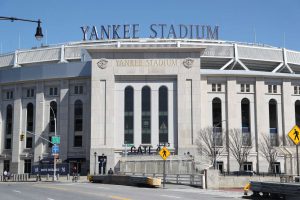
Image: MLB Opening Day Postponed Due To Coronavirus. – Al Bello
Given the danger large crowds at sporting arenas pose for spreading the disease and the likelihood that different cities will hit their coronavirus peaks at different times, professional sports will look very different whenever they resume. Even alternating rows and seats to account for social distancing may not be an option because of the danger of crowded chokepoints such as entrance gates and bathrooms.
Reports have floated the possibility of Major League Baseball starting the 2020 season with all 30 teams playing games at Arizona’s Chase Field – home of the Diamondbacks – without live spectators, or having the teams play an adjusted schedule against spring training opponents in Arizona and Florida. The league’s hefty television contract provides a safety net that can sustain the plummet in ticket revenue. It can be done: Teams in Italy’s Serie A played similar games without crowds in late March, for example, before the spread of the virus in that country forced a complete shutdown.
“You could start with games with players and the support staff only, and then gradually loosen restrictions and let in more spectators as the situation gets better,” Murphy said.
But for now, MLB and other major American professional sports leagues remain in a state of limbo with their return uncertain.
ENTERTAINMENT
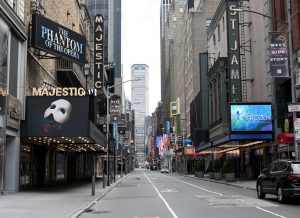
Image: Broadway Closure Extended Until June 7th. – Jamie McCarthy
The show must eventually go on.
News that the lights on Broadway will continue to be out through at least June is not a surprise given how tightly packed the seating is in those theaters, which makes restricting seating to keep 6 feet distance between patrons difficult.
“I could see reopening Broadway theaters in a few months if you took some precautions,” Murphy said. “For example, if you had ushers giving out masks to all the theatergoers as they enter the theater.”
The same holds true for concerts, which rely on packing large crowds into clubs or arenas. Experts say it will take a while to be able to set concrete dates for new and rescheduled shows. In the meantime, music promoters such as Live Nation have started livestreaming “virtual” sessions with musicians, an option that could potentially be monetized.
The coronavirus pandemic has also been pure horror for the film industry, from the studios to the multiplexes. Before shutdown orders for nonessential businesses hit, though, movie theaters had already started moving toward alternating rows and seats.
“When life does return to normal, there’s going to be a huge desire to have communal experiences again,” said Phil Contrino, spokesman for the National Association of Theatre Owners. Contrino says some smaller theaters have found creative ways to survive, such as selling popcorn and concessions for takeout, and there has been a resurgence in interest at the country’s small number of remaining drive-through theaters.
But it’s going to be a while before those drive-ins have new films to show: Disney, for example, moved its March 27 release date for the live action “Mulan” to July 24, and shifted the Marvel movie “Black Widow” from May 1 to Nov. 6. Warner Bros. shifted its own superhero flick “Wonder Woman 1984” from June to Aug. 14. Universal proved even more cautious, moving the ninth installment of its “Fast & Furious” franchise to next year. Universal is owned by NBCUniversal, the parent company of NBC News.
“Movie theaters will likely suffer a long time before things get back to approximately normal,” Vogel said. “Unless a film is very compelling to see, you may not want to sit in a crowded theater with people for three hours.”
EDUCATION
Switching to remote learning has had uneven results across the country, but at least at the university level, online learning could have long-ranging implications even after it’s safe to return to those 500-seat 101-level courses.
“I could foresee even a situation where they might offer two tiers — one pricing that you get to go onto campus and interact with the professors and another pricing level where it’s all online, but you get the same degree,” Amadeo said. “That could open up higher education to more people by lowering the cost.”
SOCIAL GATHERINGS
There has already been a shift to virtual memorial services in this period of flattening the curve. Funerals that would normally bring families together are considered dangerous scenarios with the potential to spread the disease further.
“In the coming months, it would be unfair — and probably emotionally devastating — to assume that major life (weddings, births, showers) and end of life (funerals) events will look the way they did before COVID-19,” Balkus said. “In my opinion, there could be alternative ways to hold these important life events, but it is hard to say exactly what they would look like as it would depend on what level of social distancing measures were in place at the time.”
Veteran New York-based wedding planner Jennifer Brisman says the industry has seen receptions booked through the next 60 days largely postponed to the fall or into next year, with couples especially proactive about moving destination weddings that require the extra uncertainty of air travel.
“There’s a common sense that everybody I know is deploying right now,” she said. “It’s not about the couple, it’s about the family, it’s about the community right now. No one wants to put anyone else in danger.”
Planning, however, doesn’t have to be put on hold.
“The best thing that couples who are planning for 2021 weddings and beyond can do, is research vendors and book them,” Jeffra Trumpower, senior creative director of WeddingWire, said by email. “Much of wedding planning can be done in the comfort of your own home, including virtual venue tours. What these professionals need is a means to keep their lights on until weddings are permitted again, and putting deposits down for future services is extremely helpful to them.”
Some couples are going through with their vows now, with a reception to eventually follow.
“Virtual celebrations are certainly not replacing live ones, but we’ve seen many stories of couples marking their original wedding dates in creative ways at home or virtually — whether it’s just two of them, with immediate family, or even via video conference or Livestream — until they can host a more formal ceremony and reception at a later date,” Trumpower said.
SOCIETY
Ergo’s team of analysts and epidemiologists mapping the course of the pandemic also are anticipating an increasing pull between two very different impulses among Americans.
“On one hand, there’s this sense that you can’t go to the park right now because you’re preventing older people from getting the disease, and that’s great,” Eddy said of the civic duty on display that has made social distancing possible on an unprecedented scale.
“But it’s impossible that in the next month you’re not going to see an increase in social unrest and crime (as the economic crunch grows),” he added.
Some of that is already on display with a rise in domestic violence calls amid statewide lockdowns. A spike has also been reported in hate crimes against Asian Americans, blamed on a push by the White House to call the coronavirus, the “Chinese virus,” after its country of origin.
“The question is are we going to find our way to our better angels or are we going to revert to type,” Eddy said.
Courtesy/Source: NBC News








































































































